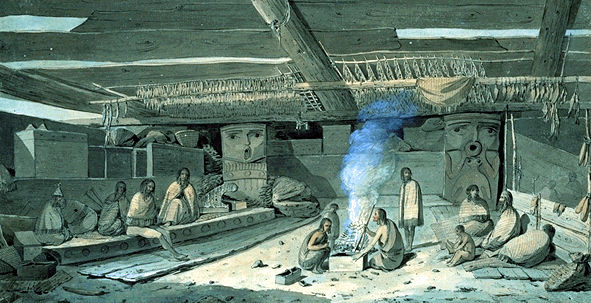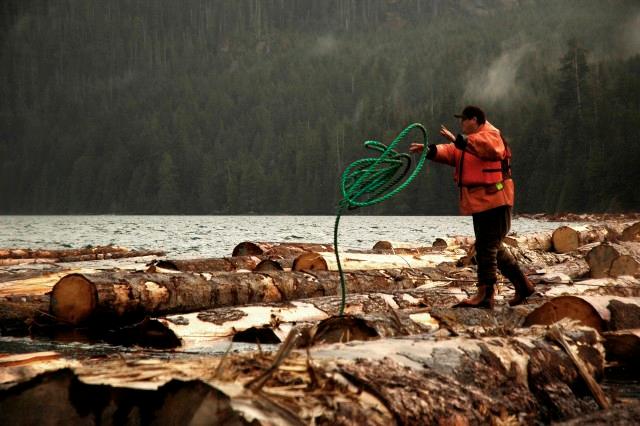Territory and Population
The traditional territories of the Ehattesaht include the Esperanza Inlet, Zeballos Inlet and part of Espinosa Inlet on Vancouver Island, British Columbia. Their village of Tatchu (what is now the beach near Tatchu Point) was once a common fishing site and place where the Ehattesaht would gather to feast. Today the most populated village is Chenahkint at Queen’s Cove. According to the federal government, there are 539 registered members of the Ehattesaht First Nation, as of October 2021.
Traditional Life

Like other Nuu-chah-nulth nations, the Ehattesaht were (and still are) a fishing community. They subsisted mainly on salmon, halibut and other local fish species as well as inland game and vegetation. The Ehattesaht travelled to and from fishing sites on foot or in dugout cedar canoes.
Traditionally major suppliers of dentalia shells, the Ehattesaht were part of a large Indigenous trade network. Dentalia shells were likened to currency in precolonial days and were consequently highly valued trade objects among Indigenous peoples, particularly on the Northwest Coast. (See also Northwest Coast Indigenous Peoples in Canada.)
Society and Culture

In pre-contact days, the Ehattesaht consisted of various bands which, decimated by disease and warfare, eventually amalgamated. Today, the Ehattesaht are led by hereditary chiefs and elected leaders.
Nuu-chah-nulth nations have a strong ceremonial culture, characterised by feasting and entertainment with song, dance, contests and theatricals. (See also>Potlatch.) The Nuu-chah-nulth are also known for their stunning woodwork, including canoes, totem poles, multifamily houses and other products hand-crafted out of fine cedar. (See also Northwest Coast Indigenous Art.)
Language
Ehattesaht people speak the Nuu-chah-nulth language. They also have their own dialect, known as Ehattesaht/Chinehkint or ʔiiḥatis, which is highly endangered. According to the Province of British Columbia, there are 52 speakers of this language, only two of whom are fluent; the remaining either somewhat understand the language (15 people) or are learning it (35 people). There have been efforts at revitalization; in 2007, the Ehattesaht Music Group began working on a language revitalization album that sets phrases spoken by elders to music. (See also Northwest Coast Language Families and Indigenous Languages in Canada.)
Religion and Spirituality
The Nuu-chah-nulth belief system centres on a Creator being as well as spirits whose powers can be used to bring peace and fortune. The Nuu-chah-nulth believe that all life forms have a spirit, and should therefore be respected and appreciated. Shamans ensured the spiritual health of the people by practising ancient medicines and healing rituals to cure illness and restore balance to the soul.
Colonial History
The Ehattesaht made contact with European fishers and traders in the late 1700s. Increased European settlement in Ehattesaht traditional territories meant significant changes for Ehattesaht daily life. Forced onto reserves, the Ehattesaht were also made to assimilate to white, Christian culture through federal programs and policies such as residential schools. Ehattesaht culture has survived in spite of these dark moments in Canadian history.
Traditional Rights
In 2014, the Ehattesaht won its court case against the Province of British Columbia over the right to consult on decisions pertaining to the use of resources in their territory. The province’s Ministry of Forests had initially made a deal with Western Forest Products to grant close to one million cubic metres of timber on Ehattesaht territory without consulting the First Nation. The Ehattesaht took the Province and the forestry company to court, and in 2014, the B.C. Supreme Court decided that the timber deal was null and void because the ministry had a responsibility to first consult with the Ehattesaht. (See also Duty to Consult.)
Contemporary Life
The Ehattesaht First Nation operates various companies on their territory such as an oyster farm (We’Shuk) and logging company (Aat’uu).
The Ehattesaht are one of the 14 nations represented by the Nuu-chah-nulth Tribal Council, an association founded in 1958 that provides various services to approximately 9,500 registered members, including child welfare, education, employment training and other socio-economic programs that support health and development.
The Ehattesaht, along with six other Nuu-chah-nulth nations, are in stage four of a six-stage treaty process in British Columbia to achieve self-government.

 Share on Facebook
Share on Facebook Share on X
Share on X Share by Email
Share by Email Share on Google Classroom
Share on Google Classroom




